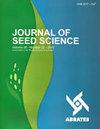Quantification and conceptual validation of the inoculum potential of Sclerotinia sclerotiorum in soybean and bean seeds
IF 1.2
4区 农林科学
Q3 AGRONOMY
引用次数: 0
Abstract
Abstract: The fungus Sclerotinia sclerotiorum, the causal agent of white mold, is widespread throughout the world. The disease is considered to be one of the major diseases of soybean and bean crops in Brazil. The pathogen S. sclerotiorum is spread by soybean and bean seeds both in the form of sclerotia and dormant mycelium inside the seeds. The objective of this work was to evaluate the relationship between different potentials of S. sclerotiorum in soybean and bean seeds and the performance of these seeds, as well as to verify the localization and quantification of the inoculum of the pathogen in the seeds inoculated by Real-time PCR (qPCR), validating the term inoculum potential. Soybean and bean seeds were inoculated with the fungus by the osmotic conditioning method based on the exposure of the seeds to the fungus for periods of 24 h, 48 h, 72 h, and 96 h. Molecular analysis was carried out by means of qPCR in whole seeds and dissected in the integument, cotyledon and embryonic axis. The results showed that the effects of S. sclerotiorum on seed germination and vigor were progressive and proportional to the increases in inoculum potentials, since there was more severe damage to the seeds and consequently to the emerged plants at the highest potential (P96). The inoculum of the pathogen was found in all parts of the evaluated seeds, even at its lowest inoculum potential (P24), with an increasing DNA concentration, and the integument obtained a greater amount of DNA than the embryo, in comparison.大豆和大豆种子菌核菌接种势的定量和概念验证
摘要:菌核菌(Sclerotinia sclerotiorum)是白霉菌的病原,在世界范围内广泛分布。该疾病被认为是巴西大豆和豆类作物的主要疾病之一。菌核病菌通过大豆和大豆种子以菌核和种子内休眠菌丝体的形式传播。本研究的目的是评价大豆和大豆种子中菌核病菌不同势与种子性能之间的关系,并验证实时荧光定量PCR (Real-time PCR, qPCR)接种种子中菌核病菌接种量的定位和定量,验证接种势的概念。采用渗透调节法对大豆和豆类种子进行24、48、72、96 h的真菌接种,对全粒种子、被皮、子叶和胚轴进行qPCR分子分析。结果表明,菌核菌对种子萌发和活力的影响是渐进式的,且与接种势的增加成正比,在最高接种势时,对种子的伤害更严重,对出苗的伤害也更大(P96)。在被评估种子的所有部位都发现了病原体的接种量,即使在最低接种量(P24)时,DNA浓度也在增加,相比之下,被皮获得的DNA量大于胚。
本文章由计算机程序翻译,如有差异,请以英文原文为准。
求助全文
约1分钟内获得全文
求助全文
来源期刊

Journal of Seed Science
Agricultural and Biological Sciences-Agronomy and Crop Science
CiteScore
2.00
自引率
30.00%
发文量
28
审稿时长
12 weeks
期刊介绍:
From 2017 the Journal of Seed Science (JSS) will circulate online version only.
Original scientific studies and communications, not yet published or submitted to another journal for publication and written in Portuguese or English, will be accepted for publication. For manuscripts submitted in English, the authors should provide an adequated version.
The SCIENTIFIC COMMUNICATION is a category of scientific manuscript which describes a technique, an equipment, new species or observations and surveys of limited results. It has the same scientific rigor as the “Scientific Articles” and the same value as a publication. The classification of a manuscript as a SCIENTIFIC COMMUNICATION is based on its content and scientific merit but it can be a preliminary study, simple and not definitive on a certain subject, with publication justified by its uniqueness and contribution to the area.
The Editorial Board of the JSS may invite leading authors of recognized reputation to compose specific Review Articles covering topics of their specialization that will convey to the scientific community the state-of-the-art knowledge related to the specific theme.
 求助内容:
求助内容: 应助结果提醒方式:
应助结果提醒方式:


